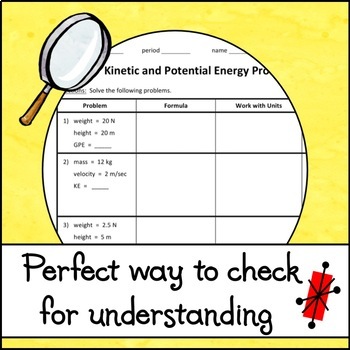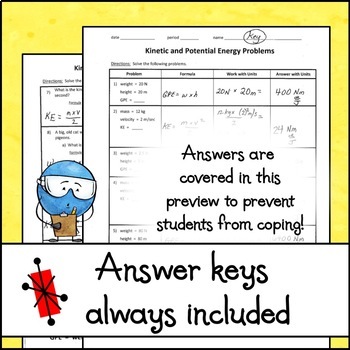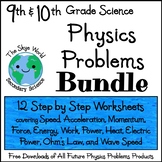Kinetic and Potential Energy Problems Worksheet
- PDF
What educators are saying
Also included in
- This bundle of worksheets will prepare students to solve simple physics problems including speed, acceleration, momentum, force, energy, work, power, power, heat, electric power, Ohm's law, and wave speed. By completing these activities, 9th and 10th grade science and conceptual physics science stPrice $24.00Original Price $36.00Save $12.00
- Designed and refined over the years, I created these lessons to meet the needs of my students as well as to keep things simple and concise. Let my years in the classroom help make your life easier!- this bundle includes everything you need to introduce your students about understanding work, power,Price $16.00Original Price $24.00Save $8.00
- This growing bundle covering a year of curriculum for 9th and 10th grade physical science (integrated physics and chemistry) includes the bundles of activities listed below. All lessons are aligned to the TEKS (Texas Knowledge and Skills). Bundles include notes, worksheets, card sorts, task cards,Price $274.00Original Price $420.00Save $146.00
Description
This activity will prepare students to solve simple problems including kinetic and potential energy calculations. By completing this activity, 9th grade science students will learn to calculate K.E. and G.P.E. (gravitational potential energy) problems step by step with columns for formula, work and answer with units.
Important Information
- Answer keys always included
- No calculators required - review basic math skills
- Recommended for Physical Science, IPC, General Science, and Conceptual Physics (algebra based)
TEKS Covered
6.8A
I.5A
NGSS Standards Covered
MS-PS3-1
HS-PS3-1
This product is also part of the following money saving bundles
Related Resources
Terms of Use – copyright ©Catherine Skye All rights to this product are reserved by author. This authorizes one teacher to use this product. If you want to share it with other teachers, please purchase a license to share this work. Copying by more than one teacher, classroom, department, school, or school system is prohibited UNLESS you purchase a license. Clipart and elements found in this PDF and others on my site are from the public domain unless otherwise noted. All products on my site are intended for classroom and personal use and may not be digitally copied for reuse in any form. Any misuse is considered copyright infringement and violates the DMCA (Digital Millennium Copyright Act).








